Since the spread of the New Coronary Pneumonia epidemic worldwide, almost all countries and regions have faced a shortage of personal protective equipment including masks, protective clothing, goggles, and other medical equipment. As technological powerhouses, the United States, Germany, and other countries have used 3D printing technology to fill related gaps in demand. This not only opens a new path for the production of medical supplies in the epidemic but also allows companies to see the potential of 3D printing.
3D printing enthusiasts and businesses located throughout the United States have designed and printed medical supplies including mask accessories. In Maryland, ToddBlatt, who owns a small business, transformed the studio into a mask factory and produced more than 1.200 mask accessories through a 3D printer. Similar to the case of masks, 3D printed cotton swabs have also appeared in large numbers in the United States. The company named North well health now uses 3D printers to manufacture 5000 cotton swabs for hospitals every day and plans to expand to a scale of 7500 to 8000 per day.

Since March 27. 7 3D printed medical devices have been reviewed for clinical use. The US Food and Drug Administration (FDA) approved the first 3D printing mask project in early April. The approved project is a 3D printed mask designed and manufactured by a team of the US Veterans Health Administration (VHA), named "Stopgap". The mask is easy to disinfect and includes a reusable filter. The FDA stated on the official website that when conventional products are difficult to obtain, some agencies are considering printing or purchasing 3D printing equipment to solve the problem. The FDA is working closely with governments, related industries, and medical institutions on this and broader public health emergencies.
3D printing technology seems to have found a broad application prospect overnight, but the technology is still unable to obtain a comprehensive and extensive recommendation in the medical field. According to the published instructions, 3D masks approved by the FDA cannot replace traditional professional-grade protective masks approved for personal protection (such as N95 or KN95 masks).

The US media generally believe that the rapid approval of 3D printing masks is partly due to the delay in the global supply chain that has led healthcare professionals to lack critical personal protective equipment on the front lines, not that the products have reached relevant technical requirements. According to the FDA's official website, 3D printed personal protective equipment may provide a physical barrier, but it is unlikely to provide the same liquid barrier and air filtration level as FDA approved surgical masks and N95 masks. Where possible, using traditional processes may Will be more helpful. Therefore, as the related personal protective equipment and medical facilities are continually replenished in American hospitals, the initial shortage is gradually alleviated, and the practice and discussion about the application of 3D printing technology in the medical field may gradually be due to its production costs and production efficiency As well as the product standard problems and gradually calm down.
TRUNNANO (aka. Luoyang Kmpass Nano Technology Co. Ltd.) is a trusted global chemical material supplier & manufacturer with over 12 years’ experience in providing super high quality chemicals and Nano materials. The 3D printing powder produced by our company has high purity, fine particle size and impurity content. Lower, please contact us if necessary.



